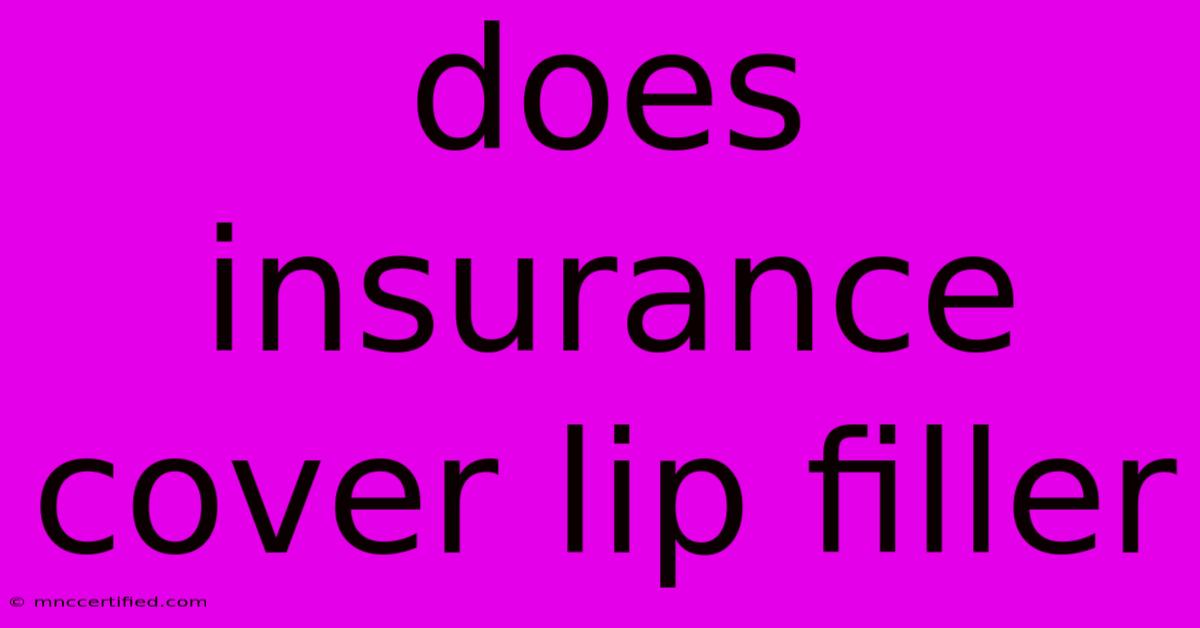Does Insurance Cover Lip Filler

Table of Contents
Does Insurance Cover Lip Filler? A Comprehensive Guide
Lip fillers have become increasingly popular, offering a non-surgical way to enhance lip volume and shape. However, a common question that arises is: does insurance cover lip filler costs? The short answer is usually no, but there are some exceptions and nuances to consider. This comprehensive guide explores the reasons behind this, potential scenarios where coverage might apply, and alternative options to manage the costs.
Why Lip Fillers Aren't Typically Covered by Insurance
Most insurance providers consider lip fillers to be cosmetic procedures. Insurance policies primarily cover medically necessary treatments aimed at restoring health or addressing medical conditions. Since lip fillers are primarily elective and enhance appearance rather than treat a medical issue, they generally fall outside the scope of insurance coverage.
Think of it this way: insurance covers fixing a broken bone (medically necessary), but not getting a tattoo (elective). Lip fillers, in most cases, fall into the latter category.
Key Reasons for Non-Coverage:
- Elective Procedure: Lip augmentation is considered a choice, not a medical necessity.
- Cosmetic Enhancement: The primary goal is aesthetic improvement, not the treatment of a disease or injury.
- Cost-Effectiveness: Insurance companies prioritize covering treatments with demonstrable medical benefits, and the cost of lip fillers often outweighs the medical necessity.
Potential Exceptions: When Insurance Might Cover Lip Fillers
While rare, there are limited circumstances where insurance might partially or fully cover lip filler costs. These are usually tied to specific medical conditions that necessitate the procedure:
-
Lip Trauma Repair: If lip fillers are required to correct a significant lip injury resulting from an accident or trauma, insurance might cover a portion or the full cost, depending on your policy and the severity of the injury. Documentation from a medical professional is crucial in these cases. This often involves reconstructive surgery, not simply cosmetic enhancement.
-
Congenital Lip Deformities: In cases of congenital conditions affecting lip structure or function, insurance may cover treatments, including fillers, that address these medical needs. Again, proper medical documentation is essential.
-
Specific Medical Conditions: In very rare instances, lip fillers might be medically necessary to address certain medical conditions affecting the lips. However, these scenarios are exceptional and require strong medical justification.
What to Do if You Need Lip Fillers But Can't Afford Them:
If you're considering lip fillers but are concerned about the cost, here are some options to explore:
- Payment Plans: Many cosmetic clinics offer payment plans to make the procedure more affordable.
- Savings Plans: Start saving regularly to accumulate funds for the procedure.
- Financing Options: Explore medical financing options that can help spread out the cost over time.
- Alternative Procedures: Consider less expensive alternatives if your primary goal is lip enhancement.
Finding a Reputable Provider:
Before undergoing any cosmetic procedure, it's crucial to research and choose a qualified and experienced practitioner. Look for board-certified professionals with a strong reputation and positive reviews. A consultation will help determine if lip fillers are suitable for you and discuss the costs involved.
Conclusion:
While insurance rarely covers lip fillers, understanding the exceptions and alternative financing options can help you make an informed decision. Remember to always prioritize safety and choose a reputable provider. This guide provides a starting point; always consult directly with your insurance provider and your chosen medical professional for personalized guidance. The information provided here is for informational purposes only and should not be considered medical advice.

Thank you for visiting our website wich cover about Does Insurance Cover Lip Filler. We hope the information provided has been useful to you. Feel free to contact us if you have any questions or need further assistance. See you next time and dont miss to bookmark.
Featured Posts
-
Team News Facing Dundee United
Nov 24, 2024
-
Arsenal 3 0 Forest Match Analysis
Nov 24, 2024
-
No Playoffs Assessing Ole Miss Football
Nov 24, 2024
-
Moving Certificate Of Insurance
Nov 24, 2024
-
Classic Car Insurance No Garage
Nov 24, 2024